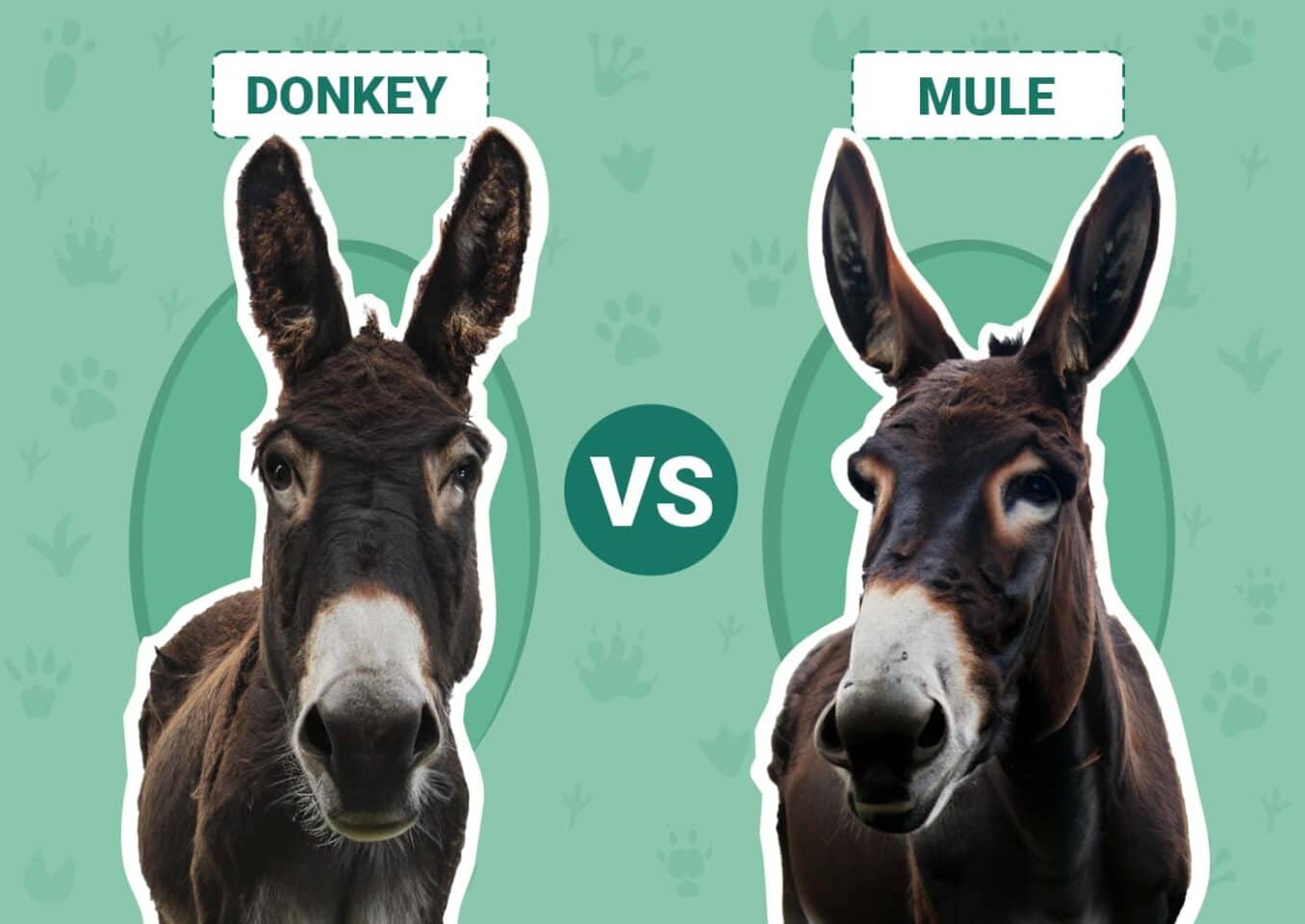Donkeys and mules are closely related, which you might have guessed from their similar appearance. They’re so closely related that many people have a hard time telling them apart. Like horses, donkeys and mules are both part of the same Equidae family, so they all share a lot of similarities. But horses are quite easy to tell apart from donkeys and mules; donkeys and mules aren’t quite as easy to tell apart from each other.
So, what are the differences between these two animals? Both are used in many of the same ways, including light draught work, riding, and even as pets, so they’re similar in more than just appearance. We’re going to go deeper to see where these two related creatures differ.

Visual Differences
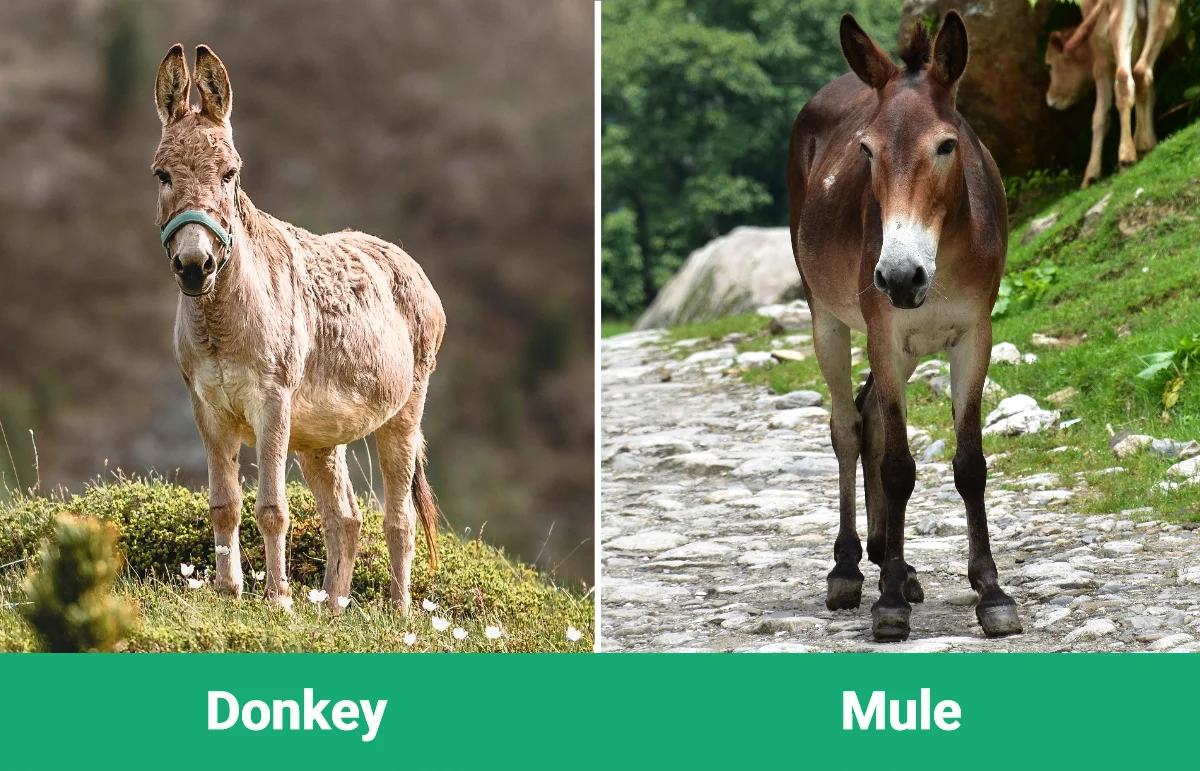
At a Glance
- Average height (adult): 36–60 inches
- Average weight (adult): 400–1,100 pounds
- Lifespan: 25–30 years
- Exercise: 1+ hours a day
- Grooming needs: Moderate
- Family-friendly: Yes
- Other pet-friendly: Often
- Trainability: Intelligent but stubborn
- Average height (adult): 46–70 inches
- Average weight (adult): 600–1,500 pounds
- Lifespan: 35–40 years
- Exercise: 2+ hours a day
- Grooming needs: Moderate
- Family-friendly: Yes
- Other pet-friendly: Often
- Trainability: Intelligent, docile, gentle
Donkey Overview
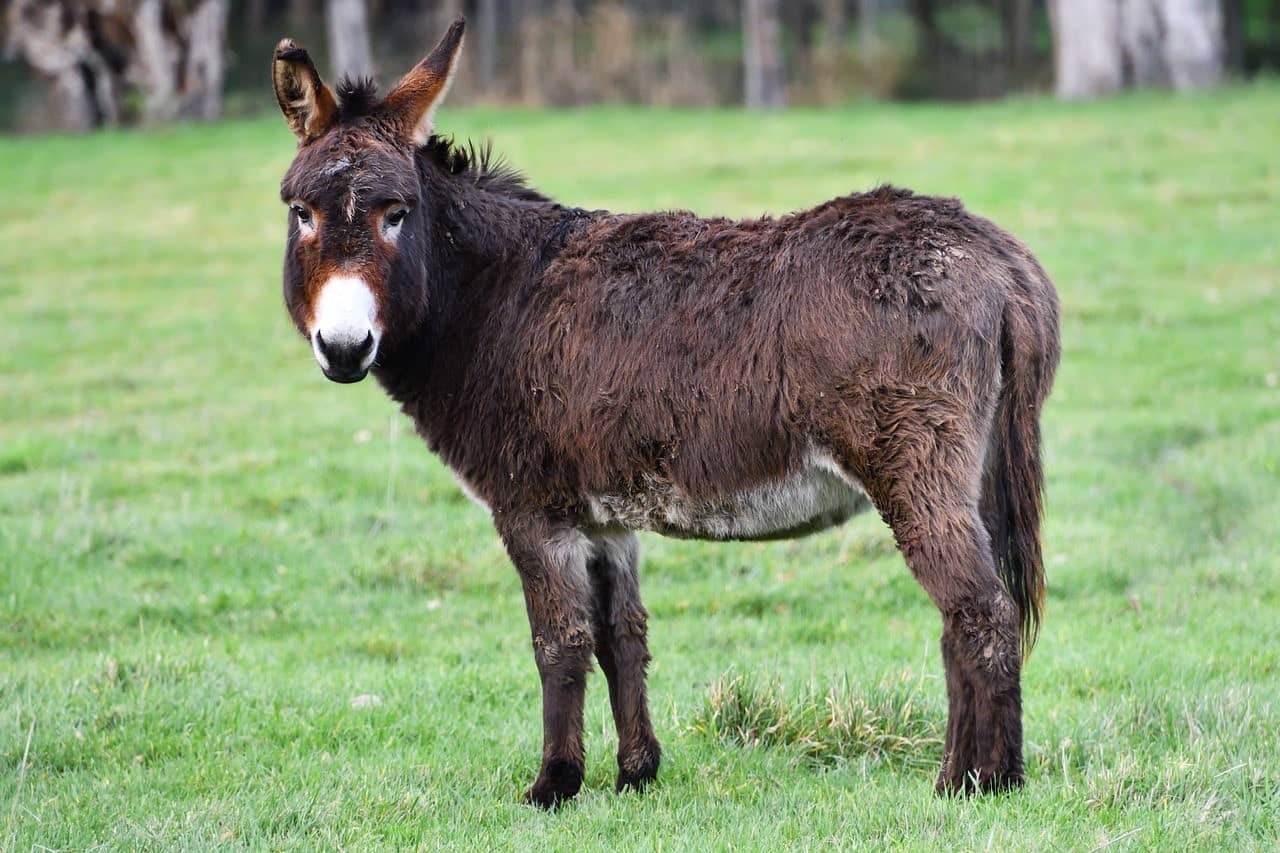
Donkeys are known for being stubborn, though they’re actually quite friendly creatures. Moreover, they’re very hardy and strong. In fact, a donkey will be stronger than a horse of comparable size. And these creatures are also quite intelligent with excellent memories. They can even recognize places and other donkeys that they haven’t seen for up to 25 years!
Origin
Donkeys have been working alongside humans for millennia. We first domesticated them around the same time that we domesticated horses, and for similar reasons, though donkeys weren’t really intended for riding. Descendants of the Wild African Ass, donkeys were employed as workers, being used to draw carts and haul loads. They were first used and domesticated in Africa, most likely in Egypt or Mesopotamia, about 5,000–6,000 years ago.
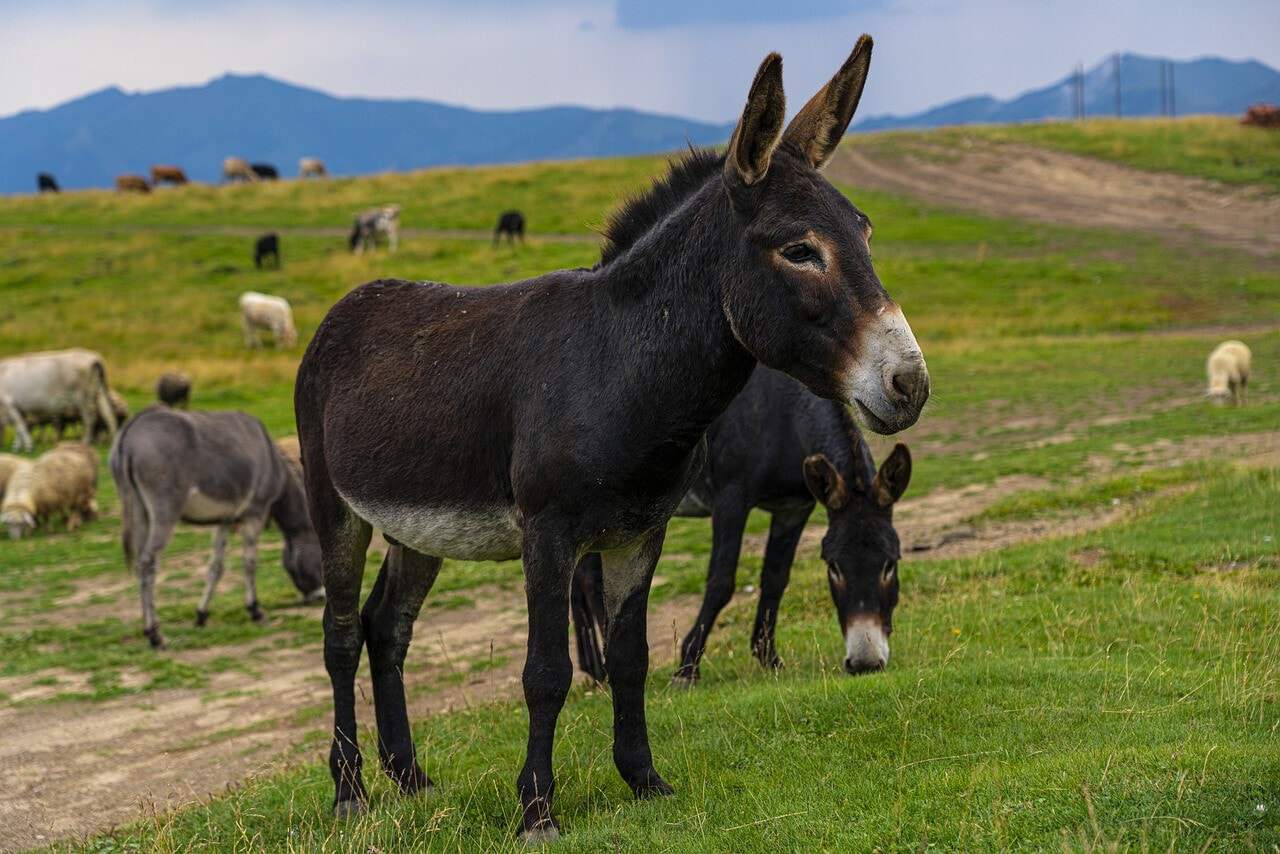
Size
Donkeys come in various sizes today, including miniature, standard, and mammoth. But even mammoth donkeys only stand about 56-60 inches in height or 14–14.5 hands. Compared to a horse or even a mule, that’s not very large. And remember, we’re talking about mammoth donkeys here; the largest of their species. Standard donkeys stand even shorter at just 36–56 inches. And miniature donkeys can be even shorter than 36 inches!
Since they’re smaller in stature, it shouldn’t be surprising that donkeys aren’t as heavy as horses or mules. A standard donkey will weigh about 400–600 pounds. Meanwhile, mammoth donkeys are about 950 pounds on average and top out at about 1,100 pounds for the largest specimens.
Feeding
One great thing about donkeys is that they don’t require very much feed for their size. Farmers joke that donkeys can get fat on air, but this is a very useful characteristic in many parts of the world where feed is scarce and expensive. This is part of the reason that donkeys are so prevalent as work animals around the world with more than 50 million being used worldwide.

Suitable For:
Donkeys are suitable for many situations. They’re one of the most commonly used work animals, particularly in lesser developed countries. Thanks to their low feed requirements, donkeys are easy and affordable to keep. They’re also strong, hardy, and great for working. But many people also keep donkeys as companions for their other livestock or even just as pets!

Mule Overview

Though donkeys look vaguely like horses, mules are much closer to horses in appearance, while still looking strangely donkey-like. It’s possible that wild mules exist, but it’s highly improbable, and practically every mule used by humans was bred on purpose. At one point, mules were highly favored; more so than donkeys or horses. Royalty often rode mules in years past, and the ancient Egyptians even preferred mules over camels as pack animals!
Origin
When you understand where mules come from, you’ll understand the key differences between them and donkeys. Mules are created by crossing a horse and a donkey. Specifically, they’re made by breeding a male donkey called a jack with a female horse, known as a mare. In essence, this gives mules the best of both worlds. They get the athleticism of a horse mixed with the hardy nature and physical strength of a donkey.
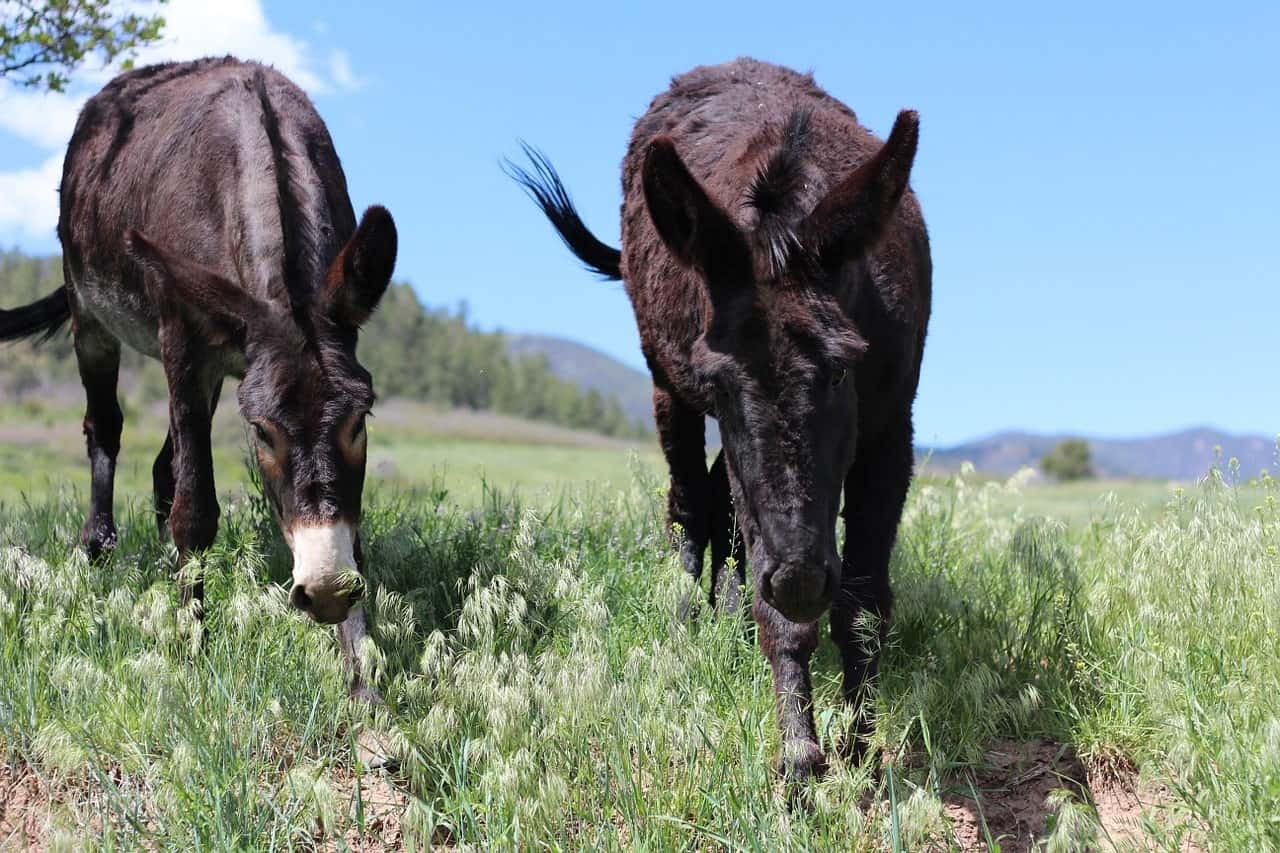
Size
Horses are considerably larger than donkeys, so it makes sense that mules are as well. Granted, there are different varieties and sizes of mules, including a miniature variety that can weigh as little as 50 pounds! But generally speaking, mules fall somewhere between horses and donkeys in size. Standard mules are about 50–70 inches tall on average (12.5–17.5 hands), making them larger than even mammoth donkeys. With weights reaching up to 1,500 pounds, mules are considerably heavier than donkeys, and they can even outweigh many horses.
Sterility
Though mules are usually very healthy creatures, there is a problem that comes along with crossing two different species, even if they are in the same family. As a result of this crossbreeding, 99.9% of mules are sterile. You can’t keep making mules by crossing two mules. The only way to make mule offspring is by breeding a male donkey and a female horse.

Suitable For:
Mules are extremely versatile creatures that are used for almost everything that horses and mules are used for. They’re perfect for someone who can’t decide between a horse and a donkey! These animals are great for draught work, pack animals, riding, cart pulling, and they’re even used in many riding shows and events like endurance races, show jumping, and dressage.
Riding
Some of the most notable differences between mules and donkeys are their uses. While both make great work animals, donkeys aren’t generally ridden. That said, mammoth donkeys are great for riding thanks to their sure-footedness and stability, but standard and miniature donkeys can’t be ridden by an adult. Standard mules, however, are often used for riding as they’re nearly as sure-footed and steady as donkeys, but they’re large enough to allow for a full-sized human to ride.

Breeding
Donkeys can be bred to create new donkey offspring, just like most animals. But mules cannot. You can’t breed two mules since mules are almost always sterile. You’ll have to breed a horse and donkey to make a mule, making it impossible to breed mules for specific traits that you want to nurture, which is much easier to do with donkeys.
Genetic Differences
Of course, these breeding differences work out to genetic differences in the end. Looking at their chromosomes, it becomes simple to see where the difference lies. Horses have a total of 64 chromosomes. Donkeys, on the other hand, have 62 chromosomes. Mules, a cross between these two species, fall right in the middle with an odd 63 chromosomes.
What About Hinnies?
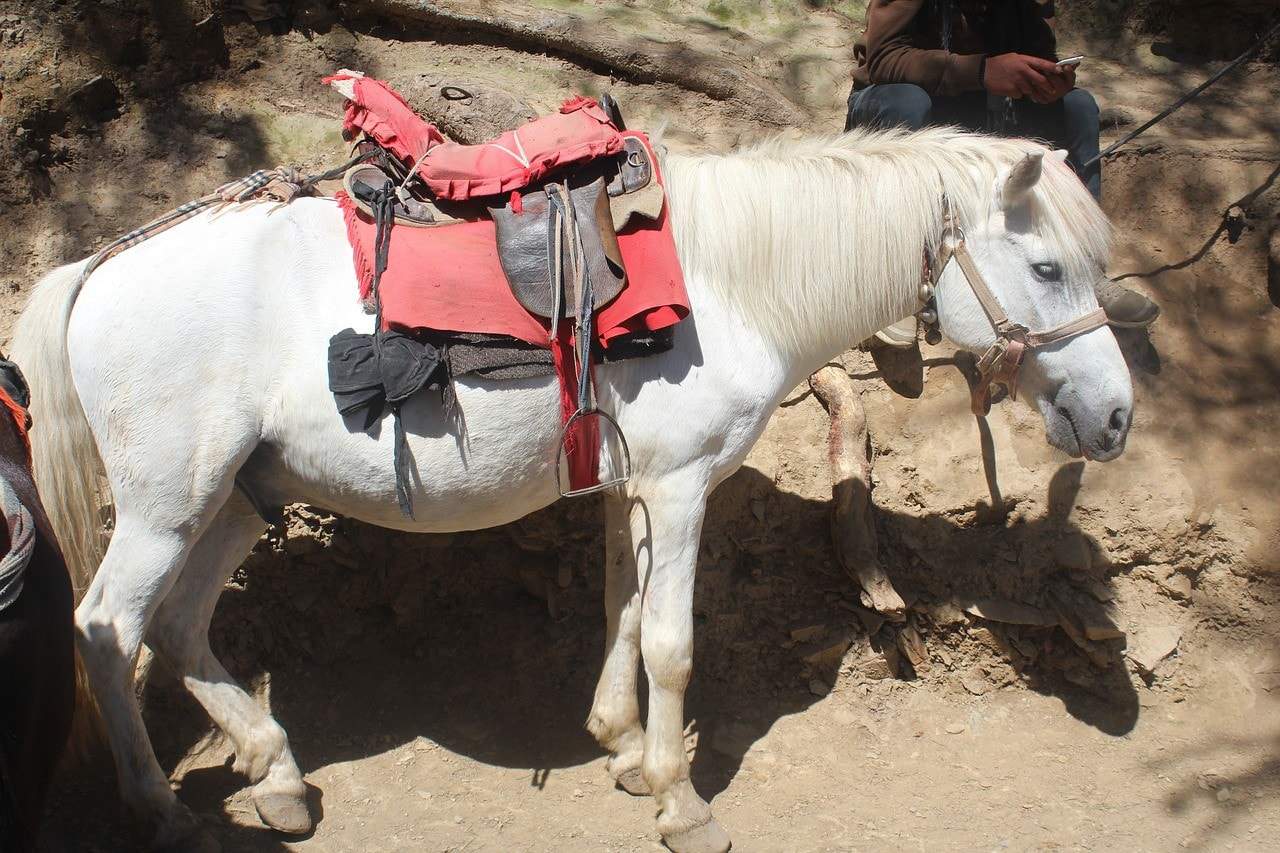
Hinnies are quite similar to mules in many regards. They’re made the same way, by crossing a horse and a donkey, only it’s opposite of mules. To make a hinny, you have to cross a female donkey with a male horse. Like mules, hinnies have 63 chromosomes and are practically always sterile. Hinnies are so similar to mules that it can be very difficult to tell them apart.

Which Breed Is Right for You?
In the end, it all depends on what you want from the animal. If you want an animal for riding, working, and everything between, then a mule is a great bet. Most donkeys aren’t suitable for riding, so they’re a better choice as companion animals for other pets or for light draught work. If you want to show your animal, choose a mule. For a maximum workload, mules are also a better choice because of their larger size. But donkeys are cheaper to keep since they don’t require as much feed, so if affordability is a factor, you might opt for a donkey instead.
- You may also be interested in: Do Miniature Donkeys Make Good Pets?
Featured Image Credit: Top – Atlantios, Pixabay | Bottom – Frank Bach, Shutterstock
